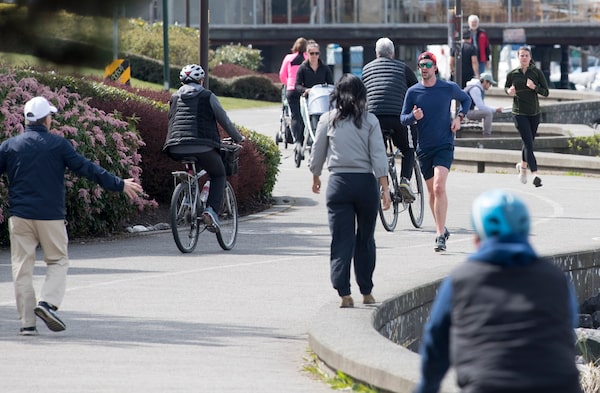
People run, bike and walk along the seawall in False Creek in Vancouver on April 6, 2020. Researchers suggest staying at least four to five metres behind others when walking in single file.JONATHAN HAYWARD/The Canadian Press
It’s one of the only loopholes left: You can still go outside to exercise as long as you respect the all-important rules of social distancing.
But is a two-metre buffer really enough for runners, cyclists, or even brisk walkers? With parks and public spaces persistently crowded, people are getting testy.
“The biggest hazard that I encounter when walking my dog is joggers,” one reader wrote after I extolled the benefits of moderate exercise for maintaining your immune system in a recent column. “They run far too close [and] they are huffing and puffing and spewing droplets from their mouths everywhere.”
Not a very flattering portrait of runners, admittedly. But new research from Eindhoven University of Technology in the Netherlands and KU Leuven in Belgium suggests that the reader may have a point: when you’re breathing hard and moving fast, droplets linger in the air over a longer distance, meaning that anyone directly behind you should leave a generous gap.
The research team was led by Bert Blocken, who is cross-appointed at both universities and studies urban physics, wind engineering, and sports aerodynamics. He and his colleagues used computational fluid dynamics (CFD) to model the movement of droplets of various size, building on earlier work by researchers in Asia after the SARS epidemic.
The largest droplets are the most likely to infect someone else, but they also fall to the ground fairly quickly. Smaller droplets linger in the air for longer, but it’s still unclear how much of a contagion risk they carry for COVID-19, Blocken emphasizes.
The simulations showed that two people walking or running side by side in calm weather have little risk as long as they maintain a two-metre gap. Even if they’re not directly side-by-side, the risk remains low as long as one person isn’t directly behind the other. But once you enter the slipstream behind someone else, those small droplets are still lingering in the air.
Based on the simulations, Blocken suggests staying at least four to five metres behind others when walking in single file, 10 metres when running or cycling slowly, and 20 metres when cycling quickly.
It’s worth noting that these results haven’t gone through the usual academic vetting. “Given the international crisis and the urgency of the situation, we have turned the normal order upside-down,” Blocken explained in an e-mail. First they did the work, then they shared the results, and only now are they applying for funding and working on a publication to submit for the usual peer-review process.
That’s cause for caution, argues Stephen Ferguson, a CFD engineer with Siemens in Britain, who wrote a recent LinkedIn post decrying the use of insufficiently validated droplet simulations to ramp up levels of anxiety about exercise exhalations during the pandemic.
“To simulate it properly, you’d have to model nasal passages and understand the particle-size distribution of mucus,” he says. “It’s literally a PhD thesis, and not something that can be knocked up by an aerodynamicist in the midst of a crisis.”
In other words, take the details of the calculation with a grain of salt. Still, Blocken’s results should give pause to those of us who hope to continue exercising outdoors. How can we continue to get our daily dose of fresh air without imperilling – or even just freaking out – those around us?
Another physicist, the University of Brasilia’s Bernardo Mello, has a suggestion for facilitating appropriate distancing. In a new paper published on the preprint repository arXiv, he modelled the number of pedestrian interactions under different conditions.
Restricting pathways to one-way travel – something that’s realistically only possible on loop circuits or roads with two sidewalks – would cut the number of interactions by about two-thirds, he found. Separating walkers from runners, so that most people are moving at similar speeds, would only add a modest further reduction.
So the advice to city planners is to establish direction-of-travel rules along busy pathways. And the advice to walkers, runners, and cyclists is to respect everyone else’s airspace. Don’t pass too close. Don’t cut in too quickly. Don’t linger behind.
Otherwise, the consequences won’t be a surprise. Authorities in Paris recently banned outdoor exercise between 10 a.m. and 5 p.m. It could happen here, too.
Alex Hutchinson is the author of Endure: Mind, Body, and the Curiously Elastic Limits of Human Performance. Follow him on Twitter @sweatscience.
Sign up for the weekly Health & Wellness newsletter for the latest news and advice.